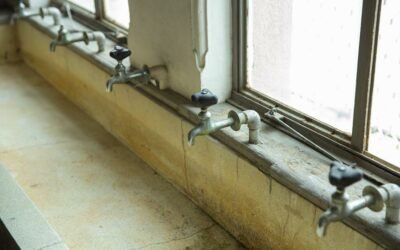Discover the power of antimicrobial paint in your fight against mold. With its active ingredients, this specialized paint not only removes existing mold but also prevents future growth.
In this article, we will guide you through the benefits of antimicrobial paint and how it effectively eliminates mold. Learn how to apply this innovative solution for successful mold remediation and safeguard your living spaces.
Say goodbye to mold problems with the help of antimicrobial paint.
Key Takeaways
- Antimicrobial paint contains additives that inhibit the growth of bacteria, fungi, and other microorganisms.
- The paint forms a protective barrier that inhibits the attachment and growth of mold spores.
- Antimicrobial paint actively inhibits mold growth and eliminates existing spores.
- Thoroughly cleaning and drying surfaces before applying antimicrobial paint is essential for optimal effectiveness.
Understanding Antimicrobial Paint
To understand the effectiveness of antimicrobial paint in mold remediation, you need to know how it works and why it's a valuable tool in combating mold growth.
Antimicrobial paint contains additives that inhibit the growth of bacteria, fungi, and other microorganisms on painted surfaces. These additives release antimicrobial agents that target the cellular structure of the microorganisms, disrupting their vital functions and preventing their reproduction.
The key to the effectiveness of antimicrobial paint lies in its ability to create a hostile environment for mold growth. When applied to surfaces, the paint forms a protective barrier that inhibits the attachment and growth of mold spores. This prevents the formation of mold colonies and stops the spread of mold throughout the area.
Antimicrobial paint not only combats mold growth but also offers long-lasting protection. The antimicrobial agents in the paint remain active even after the paint has dried, providing continuous protection against mold and other microorganisms. This makes it an ideal choice for areas that are prone to mold infestation, such as bathrooms, kitchens, and basements.
In addition to its mold-fighting properties, antimicrobial paint also contributes to improved indoor air quality. By inhibiting the growth of microorganisms, it reduces the risk of respiratory issues and allergies caused by mold spores and other harmful bacteria.
The Benefits of Antimicrobial Paint
What are the benefits of using antimicrobial paint in mold remediation?
Antimicrobial paint offers numerous advantages when it comes to tackling mold infestations. Firstly, this type of paint contains special additives that inhibit the growth of mold and other harmful microorganisms. By creating a hostile environment for these organisms, antimicrobial paint helps to prevent the recurrence of mold growth in treated areas.
Additionally, antimicrobial paint acts as a protective barrier, sealing surfaces and preventing moisture penetration. This is crucial because mold thrives in damp environments. By effectively blocking moisture, antimicrobial paint helps to eliminate the conditions that mold needs to survive and grow.
Moreover, antimicrobial paint is durable and long-lasting, offering extended protection against mold and other microbial contaminants. Its resistance to wear and tear ensures that the antimicrobial properties remain effective for an extended period of time.
Furthermore, antimicrobial paint is safe for use in various environments, including residential, commercial, and healthcare settings. It's non-toxic and low in VOCs (volatile organic compounds), making it a suitable choice for indoor applications.
How Antimicrobial Paint Removes Mold
Antimicrobial paint removes mold by actively inhibiting its growth and eliminating existing spores. The key to its effectiveness lies in its antimicrobial properties, which are designed to target and destroy mold on contact. When applied to surfaces, antimicrobial paint releases active agents that work to prevent mold from growing and spreading. These agents penetrate the mold's cell walls, disrupting their normal functioning and ultimately causing their destruction.
One way that antimicrobial paint inhibits mold growth is by creating a hostile environment for its survival. The active agents in the paint create a barrier that prevents mold spores from attaching to surfaces and forming colonies. Additionally, the paint's antimicrobial properties prevent the spores from reproducing, further hindering their ability to spread and cause damage.
In addition to inhibiting mold growth, antimicrobial paint also eliminates existing mold spores. When the paint is applied to surfaces contaminated with mold, the active agents penetrate the spores and disrupt their cellular structure. This results in the destruction of the spores, preventing them from releasing harmful toxins and allergens into the air.
Preventing Future Mold Growth With Antimicrobial Paint
You can prevent future mold growth by applying antimicrobial paint. Antimicrobial paint is specially formulated to inhibit the growth of mold and mildew on walls and other surfaces. It contains additives that prevent the growth of bacteria, fungi, and other microorganisms that can cause mold. By using antimicrobial paint, you can create a protective barrier that helps to keep your home or building mold-free.
To better understand the benefits of antimicrobial paint, let's take a look at the following table:
| Benefits of Antimicrobial Paint | How it Works |
|---|---|
| Inhibits mold and mildew growth | The antimicrobial additives in the paint hinder the growth of mold and mildew by disrupting their cellular processes. |
| Reduces allergens | Mold spores and other allergens are less likely to accumulate on surfaces coated with antimicrobial paint. |
| Improves air quality | By preventing mold growth, antimicrobial paint helps maintain a healthier indoor environment with cleaner air. |
Applying antimicrobial paint is a proactive step in preventing future mold growth. It is essential to thoroughly clean and dry the surfaces before applying the paint for optimal effectiveness. Additionally, regular inspection and maintenance are necessary to ensure the paint remains intact and continues to provide mold prevention benefits. By investing in antimicrobial paint, you can create a healthier and mold-resistant environment for yourself and your loved ones.
Applying Antimicrobial Paint for Mold Remediation
Are you wondering how to effectively apply antimicrobial paint for mold remediation? When it comes to tackling mold growth, using antimicrobial paint can be an effective solution. To ensure successful application, there are certain steps you should follow.
Firstly, it's crucial to properly prepare the surface before applying the antimicrobial paint. This involves cleaning the affected area thoroughly and removing any visible mold. Use a detergent solution and scrub the surface to eliminate dirt and mold spores. Once cleaned, allow the surface to dry completely.
Next, apply a primer specifically designed for mold remediation. This will help create a strong bond between the surface and the antimicrobial paint, ensuring maximum effectiveness. Follow the manufacturer's instructions for applying the primer, including drying times.
After the primer has dried, it's time to apply the antimicrobial paint. Choose a high-quality paint that contains an effective antimicrobial agent. Using a roller or brush, apply the paint evenly and generously to the affected area. Ensure complete coverage and allow the paint to dry according to the manufacturer's instructions.
Remember to follow all safety precautions and wear protective gear, such as gloves and a mask, when working with antimicrobial paint. Additionally, it's crucial to address the source of the mold growth to prevent future issues.
Conclusion
In conclusion, antimicrobial paint is a highly effective solution for mold remediation. Its unique properties not only remove existing mold but also prevent future growth.
By inhibiting the growth of microorganisms, antimicrobial paint creates a protective barrier on surfaces, ensuring a healthier and safer environment.
With its ability to eliminate mold and its long-lasting benefits, antimicrobial paint is an essential tool in the fight against mold and maintaining optimal air quality.






0 Comments